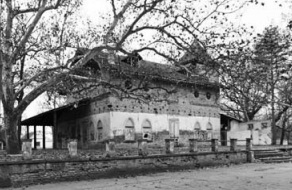Accelerated development of the civic class at the end of the XIX century there was a tendency to stay in nature, and according to the reputation of the cities of Europe, national parks, picnics, resorts and spas were formed.
On the southeastern edge of the settlement of Kanjiža, it was already the seventies of the 19th century. century decorated National Park (Néppark). Planned formed flower beds, lawns and woods, which provided a pleasant shade for rest, walking and entertainment, attracted a large number of visitors. The increase was increased by the construction of the first buildings. Vigado, a specific entertainment building and a garden house next to it, were built in 1894. Over the next year, projects, calculations and calculations of artesian baths were made. In the Sente Historical Archive, two variants of projects have been preserved, with the signatures of Sandra Cuka (Csuka Sándor) and Lajos Hoffman (Hoffman Lajos). About the realization of these facilities there is no archival documentation. In the same year, “Vigado” was leased out and projects for the restructuring of the National Park were made. The watchtower and glass garden were built in 1896.The “Swim Club” (“Fürdőrészvénytársaság”) was founded in 1897.
In the framework of the National Garden, dances and balls were held in “Vigadou”. The income from two parties per year enabled the beautification of the National Garden. The area of the artesian well was tiled in 1906. Lighting and plumbing have been introduced to the park.
Events that took place at the beginning of the 20th century represent a milestone in the development of the spa, enabling the swimming pool to be located on the territory of the National Park, which will remain on this site to this day.
Not far from the city, along the Subotica route, 6 km from the National Park was “Miracle Bath” whose medicinal properties were discovered in 1908. Next to it is a bathroom with several baths and inns. Although it was modestly decorated, it was highly visited due to its highly medicinal properties. Nevertheless, the distance of the bathroom from the city and the inadequate transport represented the brakes for further development of the spa, and “Wonderful Well” was leased, free of charge, to landowner Herman Grunfeldu (Grünfeld Herman) for 30 years, from 1913 to 1943, with the obligation to healing water from the “Pasture” which is 6 km away, through iron pipes beneath the ground, led to the National Park, and to establish baths there. To this end, the public viewed it with disbelief until 1913.the year when the spa was declared and named “The Old Kanjisko Bath of the Miraculous Well”.
Since that year, the use of medicinal mud has begun. In a separate building, a shared bathroom with 28 baths was opened. Electric lighting and central heating were introduced in 1913. The mentioned works were followed by the arrangement of the park and the pavement of the trails. Thanks to spa spa and social life Kanjiža is reviving.
“Vigado” is an object characteristic of all spa baths, at the end of the XIX century. The project was made by city architect Sandor Cuka (Csuka Sándor) in 1893. The next year the building was built.
The building is a rectangular base, somehow raised from the corner of the terrain, to an artificially formed embankment, with a wooden trim that surrounds the two sides. Access to the centrally set dance hall is made with a porch, which is oriented towards the central part
park. In contrast to the porch, the hall covers several smaller rooms, such as a dining room, a kitchen, a basement, a dressing room and stairs for the gallery.
The building is a fashionable romantic architecture built on the reputation of Swiss villas characterized by the massive use of wood. The dominant elements of Vigado consisted of a wooden porch with decorative elements and a brick construction of a tower. Facade canvas is made in a combination of yellow and red façade brick. The ground openings are ending in the form of a Gothic fractured port. Floor openings are circular with identical decoration. The roof is razed, two-hole with the trailing edge on the longer facade to the park and the accentuated tower on the shorter side.
Today, the object is out of function for decay. The entire building is in very costly condition. All wooden decorative elements were removed, and today such a “bare” object does not point to the beauty and luxury of the former central building of the National Park and Spa.
VIGADO


0 comments on “VIGADO”